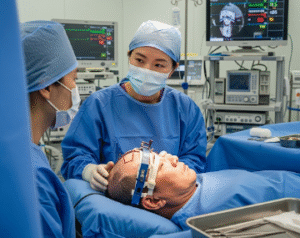Overview
Angina, also known as angina pectoris, is a type of chest pain caused by reduced blood flow to the heart muscle. It is often a symptom of coronary artery disease (CAD) and serves as a warning sign of an increased risk for heart attack or other cardiac events. Angina typically feels like pressure, squeezing, or tightness in the chest and may radiate to the shoulders, arms, neck, or jaw.
What is Angina?
Angina is not a disease itself but a clinical manifestation of an underlying heart problem—usually when the coronary arteries are narrowed or blocked. It occurs when the heart muscle doesn’t get enough oxygen-rich blood, especially during physical exertion or emotional stress.
There are several types of angina:
- Stable Angina: Predictable chest pain with activity or stress.
- Unstable Angina: Sudden, unpredictable pain; a medical emergency.
- Variant (Prinzmetal’s) Angina: Caused by coronary artery spasms, usually at rest.
- Microvascular Angina: Involves tiny coronary arteries; more common in women.
Symptoms
- Pressure, tightness, or squeezing in the chest
- Pain spreading to the shoulders, arms, neck, jaw, or back
- Shortness of breath
- Fatigue
- Dizziness or nausea
- Sweating
- Pain triggered by exertion or stress, and relieved by rest (in stable angina)
Causes
- Coronary Artery Disease (CAD): Buildup of plaque in the coronary arteries
- Coronary artery spasm: Temporary narrowing due to muscle contraction
- Anemia or low oxygen levels
- Severe hypertension or valve diseases
Risk Factors
- Smoking
- High blood pressure
- High cholesterol
- Diabetes
- Sedentary lifestyle
- Obesity
- Stress
- Age (higher risk in older adults)
- Family history of heart disease
Complications
- Increased risk of heart attack
- Development of heart failure
- Life-threatening arrhythmias
- Reduced ability to perform physical activities
- Emotional distress or anxiety due to recurrent chest pain
Prevention
- Quit smoking and avoid tobacco exposure
- Maintain a healthy diet low in saturated fats and sodium
- Regular physical activity
- Manage chronic conditions like diabetes and hypertension
- Control cholesterol levels
- Stress management
- Routine cardiac check-ups, especially with a family history
Treatment Options in Korea
South Korea provides world-class cardiac care with advanced diagnostics and minimally invasive treatment options for angina:
Medications:
- Nitrates (e.g., nitroglycerin): To relieve chest pain
- Beta-blockers: Reduce heart rate and oxygen demand
- Calcium channel blockers: Relax arteries and reduce workload
- Aspirin or antiplatelet drugs: Prevent blood clots
- Statins: Lower cholesterol levels
- ACE inhibitors or ARBs: Manage blood pressure and heart function
Interventional Procedures:
- Coronary Angioplasty & Stenting: Performed in top Korean hospitals with high success rates
- Coronary Artery Bypass Grafting (CABG): For severe or multiple blockages
Diagnostic Tools:
- Coronary angiography
- Stress testing (exercise or pharmacologic)
- CT angiogram or echocardiography
Cardiac Rehabilitation:
- Supervised exercise programs and lifestyle counseling
- Offered at specialized heart centers like Samsung Medical Center Heart Vascular Stroke Institute, Severance Hospital, and Asan Medical Center
Integrative Care:
Korean hospitals provide multilingual support, private rooms, and international patient services for seamless treatment access. Long-term follow-up and teleconsultation services are available for global patients.













